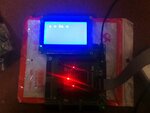zacief
Newbie level 5
hi ,
i have written a code (copied from internet) for lcd and run it on spartan-3cx250E .the problemis that some characters are missing on lcd.
there may be a issue with clock frequecy or enable signal.i dont know how to resolve this?
Thanks
the code is as follows:]
i have written a code (copied from internet) for lcd and run it on spartan-3cx250E .the problemis that some characters are missing on lcd.
there may be a issue with clock frequecy or enable signal.i dont know how to resolve this?
Thanks

the code is as follows:]
Code:
module lcd12864(LCD_N,LCD_P,LCD_RST,PSB,clk, rs, rw, en,dat);
output reg LCD_N;
output reg LCD_P;
output reg LCD_RST;
output reg PSB;
input clk;
output [7:0] dat;
output reg rs,rw,en;
//tri en;
reg e;
reg [7:0] dat;
reg [31:0] counter=0;
reg [6:0] current=0,next=0;
reg clkr;
reg [31:0] cnt=0;
parameter set0=6'h0;
parameter set1=6'h1;
parameter set2=6'h2;
parameter set3=6'h3;
parameter set4=6'h4;
parameter set5=6'h5;
parameter set6=6'h6;
parameter dat0=6'h7;
parameter dat1=6'h8;
parameter dat2=6'h9;
parameter dat3=6'hA;
parameter dat4=6'hB;
parameter dat5=6'hC;
parameter dat6=6'hD;
parameter dat7=6'hE;
parameter dat8=6'hF;
parameter dat9=6'h10;
parameter dat10=6'h12;
parameter dat11=6'h13;
parameter dat12=6'h14;
parameter dat13=6'h15;
parameter dat14=6'h16;
parameter dat15=6'h17;
parameter dat16=6'h18;
parameter dat17=6'h19;
parameter dat18=6'h1A;
parameter dat19=6'h1B;
parameter dat20=6'h1C;
parameter dat21=6'h1D;
parameter dat22=6'h1E;
parameter dat23=6'h1F;
parameter dat24=6'h20;
parameter dat25=6'h21;
parameter dat26=6'h22;
parameter dat27=6'h23;
parameter dat28=6'h24;
parameter dat29=6'h25;
parameter dat30=6'h26;
parameter dat31=6'h27;
parameter dat32=6'h28;
parameter dat33=6'h29;
parameter dat34=6'h2A;
parameter dat35=6'h2B;
parameter dat36=6'h2C;
parameter dat37=6'h2E;
parameter dat38=6'h2F;
parameter dat39=6'h30;
parameter dat40=6'h31;
parameter dat41=6'h32;
parameter dat42=6'h33;
parameter dat43=6'h34;
parameter nul=6'h35;
always @(posedge clk) //da de shi zhong pinlv
begin
counter<=counter+1;
if(counter==32'h1FFFE) begin
counter<=0;
end
else if((counter==32'hF)) begin//||(counter==32'h57FE)
clkr<=~clkr;
end
en<=clkr|e;
rw<=0;
LCD_N<=1'b0;
LCD_P<=1'b1;
LCD_RST<=1'b1;
PSB<=1'b1;
end
always @(posedge clk)
begin
if(counter==32'hF)begin //counter==32'haff0
current<=next;
case(current)
set0: begin rs<=0; dat<=8'h30; next<=set1; end
set1: begin rs<=0; dat<=8'h0c; next<=set2; end
set2: begin rs<=0; dat<=8'h1; next<=set3; end//
set3: begin rs<=0; dat<=8'h6; next<=dat0; end
// set4: begin rs<=0; dat<=8'h81; next<=dat0; end //
dat0: begin rs<=1; dat<="s"; next<=dat1; end //?????
//set5: begin rs<=0; dat<=8'h91; next<=dat1; end //
dat1: begin rs<=1; dat<="a"; next<=dat2; end
// set6: begin rs<=0; dat<=8'h89; next<=dat2; end //
dat2: begin rs<=1; dat<="j"; next<=dat3; end
// set4: begin rs<=0; dat<=8'h90; next<=dat14; end //
dat3: begin rs<=1; dat<="e";next<=dat4; end
// set4: begin rs<=0; dat<=8'h90; next<=dat14; end //
dat4: begin rs<=1; dat<="s"; next<=dat5; end
//set4: begin rs<=0; dat<=8'h90; next<=dat14; end //
dat5: begin rs<=1; dat<="h"; next<=dat6; end
// set4: begin rs<=0; dat<=8'h90; next<=dat14; end //
dat6: begin rs<=1; dat<="a"; next<=dat7; end
// set4: begin rs<=0; dat<=8'h90; next<=dat14; end //
dat7: begin rs<=1; dat<="r";next<=dat8; end
// set4: begin rs<=0; dat<=8'h90; next<=dat14; end //
dat8: begin rs<=1; dat<="e"; next<=nul; end
nul: begin rs<=0; dat<=8'h00; // ????E ? ??
if(cnt!=4'h10)
begin
e<=0;current<=set0;cnt<=cnt+1;
end
else
begin current<=set0; e<=1;cnt<=0;
end
end
default: next<=set0;
endcase
end
end
endmodule
Last edited by a moderator:
